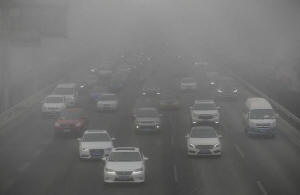|
The
region's 13 cities racked up an increase of 11.3 percent in
concentrations of hazardous breathable particles known as PM2.5
over the period, with average readings of 69 micrograms per
cubic meter, environment ministry data showed on Wednesday.
The capital, Beijing, which has promised "extraordinary" efforts
against smog this year, saw average PM2.5 concentrations reach
64 micrograms over the period, down 1.5 percent on the year, but
the amount of larger PM10 particles rose 13.6 percent.
Overall PM2.5 levels throughout China hit an average of 45
micrograms in the first seven months, the same as last year.
China's official standard is 35 micrograms, higher than the
level of 10 micrograms the World Health Organization recommends.
The Beijing-Tianjin-Hebei region has pledged to cut PM2.5 levels
by more than quarter over the 2012-2017 period. Beijing is also
under pressure to cut average concentrations to less than 60
micrograms for the whole of 2017.
Regional air quality has been improving in recent months, but
pollution near record levels in January and February drove the
increase in the seven-month average, after thick smog spurred
"red alert" warnings by dozens of cities and adoption of
emergency measures to thin traffic and industrial activity.
In April, China sent 5,600 inspectors on a year-long campaign to
enforce environmental standards in 28 northern cities, in a move
aimed at meeting the region's air pollution targets and punish
infringements of the rules.
The government has also promised to curb industrial activity
across the region this winter, with some cities expected to
slash steel production by half.
(Reporting by David Stanway; Editing by Clarence Fernandez)
[© 2017 Thomson Reuters. All rights
reserved.] Copyright 2017 Reuters. All rights reserved. This material may not be published,
broadcast, rewritten or redistributed.
 |
|






